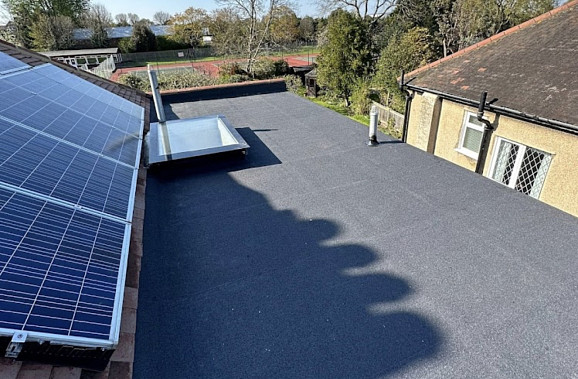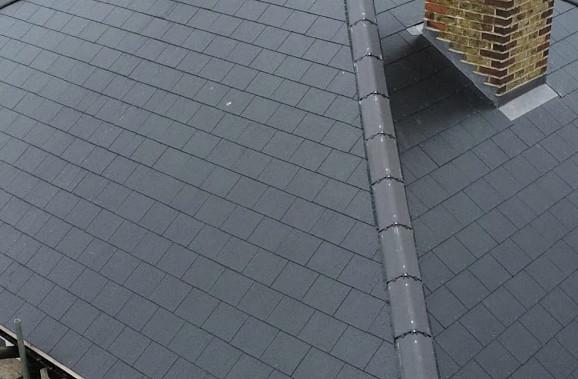When trying to select the perfect roof for your London property, quite often, the two choices you have are a pitched or a flat roof. Both options have unique advantages and drawbacks, and the choice usually depends on various factors such as location, climate, available budget, durability, functionality, aesthetics and personal preference.
At Knight Roofing, based in Battersea, we have years of roofing-related experience. This article will compare the pros and cons of both aforementioned roofing styles and provide a non-biased opinion to help you make an informed decision.
What Is A Flat Roof?
Flat roofs date back to ancient times and were initially popular in arid climates. However, they did not take off in Europe and North America until the 1800s due to the emergence of materials that could help keep water out. Flat roofs are a common feature today, especially on commercial buildings throughout the London area.
A flat roof can be described as having no slope (or a very small one), giving the appearance of a flat surface. In general, flat roofs usually have a slight pitch, allowing water to flow away from the structure. A distinctive and well-known example of a flat roof in the London skyline is the Lloyd's Building, designed by Richard Rogers.
What Is A Pitched Roof?
Pitched roofs have existed since humans started to build structures. Their primary purpose is to redirect wind and rain, helping to protect the structure they cover. Pitched roofs are also popular in countries with regular snowfalls, helping minimise the risk of damage. This classic roofing style has stood the test of time and can be seen throughout all building types in London.
Advantages Of A Flat Roof
Outlined below are several advantages linked to flat roofing.
- With a horizontal surface, having a flat roof allows for additional property usage, such as a rooftop garden, patio, and solar installation.
- Flat roofs can be cost-effective, as they often require less materials and have fewer structural needs than a pitched roof.
- Flat roof designs are usually quicker and easier to install, often making them cheaper.
- A flat roof facilitates convenient maintenance by providing straightforward and safe access.
- Flat roofs allow for equipment to be easily added, such as air conditioning units.
- Flat roofs provide a low profile, not impeding views or sunlight to such a degree.
Negatives Of A Flat Roof
Flat roofs have many selling points, however, there can also be some drawbacks. Some associated with flat roofing structures include.
- The absence of a slope, which is essential for efficient water runoff, can potentially result in water pooling in certain situations, ultimately leading to leaks.
- Flat roofs can require additional maintenance to ensure they are free of debris and have no defects.
- Insulation can be an issue compared to pictured roofs, where there is limited space to add insulating materials.
- A personal preference, however, some people do not like the look of flat roofs and feel that they lack style.
Positives Of A Pitched Roof
Pitched roofs have stood the test of time and are a very common sight throughout London. Below are some of their advantages.
- The shape of a pitched roof allows for the effective inclusion of insulation, this can be especially beneficial in the area to keep homes warm during the cold months.
- Drainage on a pitched roof is often superior when compared to flat roofs, the angle is conducive to creating efficient drainage from the roof.
- A personal preference, but many people feel that pitched roofs have more character and expression.
- Pitched roofs naturally create space, allowing for additional storage opportunities.
- The shape of pitched roofs helps ventilate a property with natural airflow.
- The angle of a pitched roof can often lead to less maintenance requirements, as debris falls off.
- Not always relevant for the London area, however, when it does snow, the slope of a pitched roof naturally allows snow to fall off. This results in less weight and stress for the structure.
Negatives Of A Pitched Roof
There are also some negatives associated with pitched roofing, but not all apply to every project. Below are some of the main ones.
- Pitched roofs can require more labour and additional materials, resulting in potentially higher costs and build times.
- Having a pitched roof can sometimes cause issues with the installation of solar panels. The angles and direction can be wrong for the most productive energy absorption.
- Maintenance and checking for issues are often more dangerous and could require additional safety precautions.
- Due to the steep pitch, it can often block sunlight and views.
- The high surface area often associated with the pitched roof design can make them less energy efficient.
Conclusion
In conclusion, both flat and pitched roofs boast their unique advantages and drawbacks. The type of roof you choose for your London property will largely depend on specific circumstances, including the location, personal aesthetic preference, and project type. Flat roofs offer cost-effectiveness, easy maintenance and potential for extra usage, such as a rooftop garden or solar installations. On the other hand, pitched roofs exhibit superior insulation, efficient drainage, natural ventilation and often a more traditional aesthetic appeal. Therefore, it is prudent to consider all these elements while making a decision. Ultimately, the choice between a flat or pitched roof comes down to which one best fulfils your personal needs and project objectives, contributing to your roofing project's overall success and longevity.




